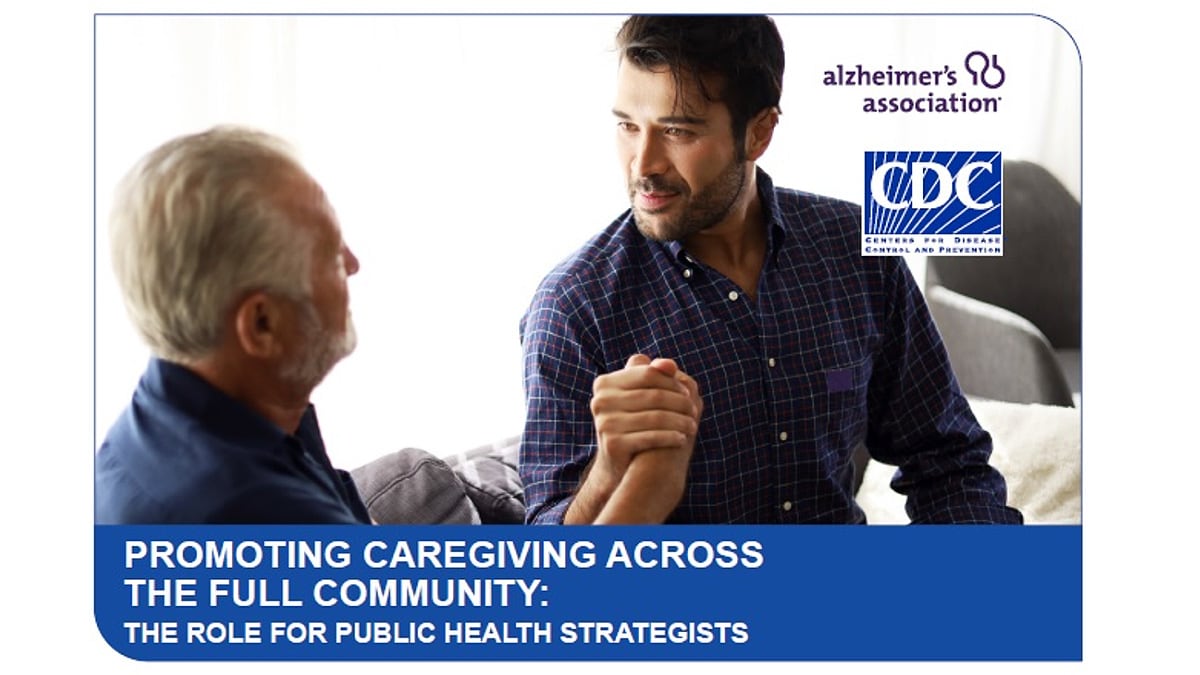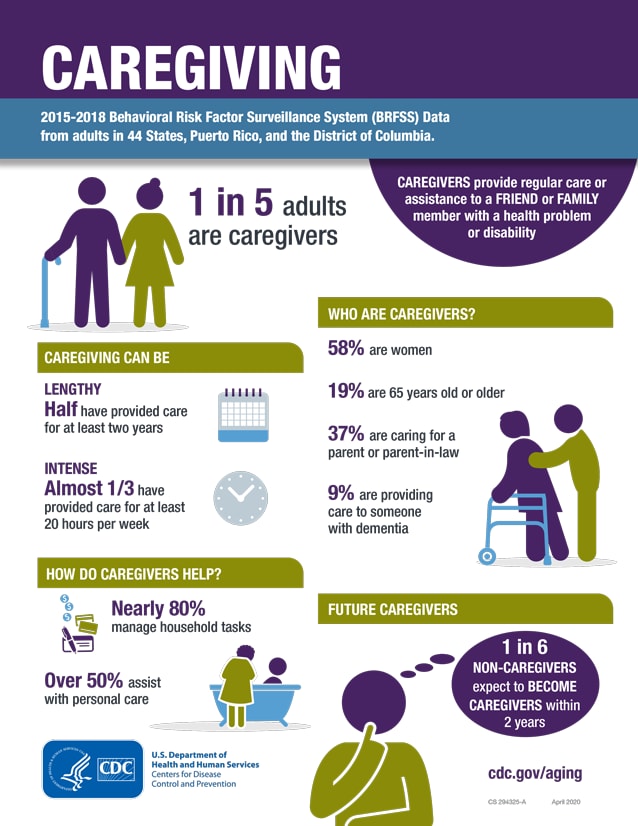What to know
- Caregiving has become an essential public health issue, as U.S. adults live longer, and chronic disease prevalence continues to rise.
- Over 53 million unpaid caregivers provide support to friends and loved ones who are older or have chronic conditions or disabilities.
- Unpaid caregiving can reduce the need for paid services from many sectors.
- Public health is uniquely positioned to gather partners from multiple disciplines to support and elevate the role of caregivers.
- This page offers information and resources for public health leaders to do that.

Overview
Caregivers are family members or friends who provide unpaid, community-based care to older adults and people with chronic health conditions or disabilities.
- Caregivers help with critical daily tasks such as grocery shopping, paying bills, bathing, dressing, and managing medicines.
- They are often a source of emotional support and companionship for care recipients.
Although caregivers provide an essential service to support our population, they face health and financial strains as a result of the role they perform.
Public health has a unique role to play in ensuring that a coordinated system of support exists for all caregivers.
Fact
Caregiving as a public health issue
Caregiving is a public health concern because the demand for caregivers is increasing as our population ages, but so too are the strains on caregivers.
Increasing demand for caregivers
- The number of caregivers increased from 43.5 million in 2015 to about 53 million in 2020.1
- By 2035, an estimated 78 million people in the United States will be 65 years or older.2
- More than two-thirds of the U.S. population will likely need help with tasks at some point in their lifetime.3
Health and financial burdens of caregiving
Caregiving is also a public health concern because it can lead to physical, emotional, psychological, and financial strain for caregivers.

Health challenges
- Nearly 1 in 5 caregivers reports fair or poor health.4
- Caregivers often neglect their own health needs, increasing their risk of having multiple chronic conditions.
- Nearly 2 in 5 caregivers have at least two chronic diseases of their own.
Financial strains of caregiving
Caregiving can negatively impact caregiver finances.
- Many employed caregivers have had to take time away from work, resulting in lost wages.
- Nearly 2 in 10 employed caregivers report having to stop working entirely.
- And 4 in 10 have had to reduce their working hours to care for a loved one.5
Caregivers sometimes pay out-of-pocket for caregiving services, meals, medical supplies, and other expenses. In a 2021 study6:
- Almost 80% of caregivers reported paying out-of-pocket for routine expenses for care recipients.
- The average annual out-of-pocket cost for caregivers was $7,200.
- This cost rose to nearly $9,000 per year for caregivers of someone with dementia.
Caregiving is an essential public health service and should be prioritized as an emerging public health issue.
A coordinated public health approach
Strong public health leadership is essential to engage community partners in driving needed structural changes. These changes can support effective, sustained caregiving for all people.
CDC and its partners have produced resources for public health agencies to build this support network and promote the dissemination of evidence-based programs for caregivers.
A public health strategy
Six high-level public health strategies to address the challenges faced by unpaid caregivers are:
- Improve access to effective interventions, services, and supports for caregiving among underserved populations and increase use of these resources to promote caregivers’ own health and well-being.
- Embed systematic identification and assessment of caregivers in health and social systems and actively assist with obtaining caregiving resources based on individual needs and preferences.
- Promote changes in policies, systems, and environments to improve the social and employment conditions that increase caregiver strain and respect the cultural context in which they live.
- Track, analyze, report on, and promote caregivers’ own health and well-being.
- Assure pandemic response and emergency preparedness plans enable continuity in the essential assistance provided by caregivers to people living with dementia.
- Shape cultural norms to respect and embrace caregiving.
The role of public health strategists
Public health agencies can promote caregivers’ health by using a “chief health strategist” approach.
- Public health leaders can engage key partners from multiple sectors, including caregivers themselves, to develop a broad approach.
- This process identifies community assets, uncovers inequities in access and use, and develops a plan that applies the best available evidence.
Call to action
The Alzheimer's Association, in partnership with CDC, has produced an action brief for health professionals to Promote Caregiving Across the Full Community. While focused on dementia caregiving, the lessons contained within the brief apply to all caregiving. This action brief offers:
- An overview of the challenges with caregiving, including for people living with dementia.
- Resources for state, local, and tribal public health leaders.
- Promoting Caregiving Across the Full Community: A Call to Action for Public Health Professionals
- Executive Summary

Resources and tools
- AARP and National Alliance for Caregiving. Caregiving in the United States 2020. AARP; 2020. Accessed October 14, 2021. https://doi.org/10.26419/ppi.00103.001
- Projected Age Groups and Sex Composition of the Population: Main Projections Series for the United States, 2017-2060. U.S. Census Bureau, Population Division: 2020. Accessed October 28, 2021. https://www.census.gov/data/tables/2017/demo/popproj/2017-summary-tables.html
- RAISE Family Caregiving Advisory Council. Recognize, Assist, Include, Support, & Engage (RAISE) Family Caregivers Act: Initial Report to Congress. Administration for Community Living; 2021. Accessed October 18, 2021. https://acl.gov/sites/default/files/RAISE-InitialReportToCongress2021_Final.pdf
- Edwards VJ, Bouldin ED, Taylor CA, Olivari BS, McGuire LC. Characteristics and health status of informal unpaid caregivers—44 states, District of Columbia, and Puerto Rico, 2015–2017. MMWR Morb Mortal Wkly Rep. 2020; 69:183–188. https://doi.org/10.15585/mmwr.mm6907a2
- Rosalynn Carter Institute for Caregivers. Working While Caring: A National Survey of Caregiving Stress in the U.S Workforce. Accessed October 15, 2021. https://www.rosalynncarter.org/wp-content/uploads/2021/09/210140-RCI-National-Surveys-Executive-Summary-Update-9.22.21.pdf
- Skufca L, Rainville C. Caregiving Out-of-Pocket Costs Study 2021. AARP Research, 2021. Accessed August 14, 2021. https://doi.org/10.26419/res.00473.001
- National Center for Chronic Disease Prevention and Health Promotion
- Reinhard SC, Feinberg LF, Houser A, Choula R, Evans M. Valuing the Invaluable: 2019 Update. AARP Public Policy Institute; 2019. Accessed October 27, 2021. https://www.aarp.org/content/dam/aarp/ppi/2019/11/valuing-the-invaluable-2019-update-charting-a-path-forward.doi.10.26419-2Fppi.00082.001.pdf

